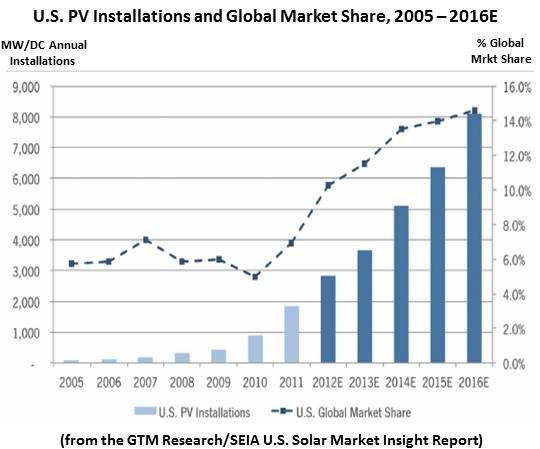Photovoltaic solar is now the concern of utilities and the nation’s biggest energy companies.
At the GTM solar summit in Phoenix last week, GTM CEO Scott Clavenna probed planners for insights into the industry’s future.
“We look at solar as a way to build clean generation and help our customers save money on the cost of their electricity and meet their sustainability goals,” offered power giant Constellation Energy’s Senior Vice President of Green Initiatives Michael D. Smith.
“With the RPS in California beginning in 2002 to 2003, we have a lot of wind and some biomass,” said J.C. Thomas, Regional Manager of investor-owned utility San Diego Gas and Electric (SDG&E), who continued, “We’re now starting to see the solar roll in on a larger scale.”
With solar’s growth, Thomas said, “We are ground zero for all its effects. One of the effects we’re seeing is the significant cost shift that’s occurring once you start net metering and the other customers are picking up the tab. It’s a serious issue.”
“We haven’t found a profitable way to invest in solar,” said Matthew Barmack, Calpine Corporation Director of Market and Regulatory Analysis, the panel’s cynic. “If you have it figured out, let us know. We’ve been through bankruptcy once before.”
On Thomas’ concern about net metering, Barmack noted that it “takes money away from conventional generators and gives it back to load. Theft is very profitable if you can get away with it.” Calpine follows solar “pretty closely,” he added, but “until the utilities start looking much harder at the operating characteristics of some of the different types of renewable resources, geothermal will not beat PV or wind.”
“Our solar business is not small, is not passive and is not pessimistic,” replied mega-player NRG Energy’s Senior Vice President for Sustainability, Strategy and Policy, Steve Corneli. “We look at solar as one of the key competitive power sources of the next decade.” But, he said, that does raise “some challenging issues about how we get from here to there.”

Clavenna asked the panel to compare wind and solar.
“Solar has advantages,” Corneli said. Wind is most productive at night, while solar “has the bulk of its production in or around the middle of the day or a little later, [and] power is worth more in the daytime.”
Solar also “has the great advantage of being close to major load centers, and the potential for distributed solar is extremely high,” Corneli said. “Today, you can put it on rooftops and parking lots and football fields and unused lands. Tomorrow, with advanced technologies, it will be in building materials, it will be on road surfaces, it will be sort of everywhere.”
Smith said there is a place for both. “Wind tends to produce more from a single grid connection and solar tends to be more distributed and provides a lot of grid flexibility and functional flexibility.”
Thomas noted that San Diego’s peak load is moving to later in the day, when solar without storage becomes “a lower value resource” to his utility. As to wind’s nighttime production, he said, “we’re trying to lead the way in San Diego to electric vehicles and that excess energy resource will be available to charge those cars at night.”
“Off-peak markets can become saturated with wind energy,” Barmack said, and solar both fails to help system operators with “load peak” and causes them trouble with its “huge ramps.” But “some resources,” he added without mentioning geothermal’s 24/7 output, “can actually be controlled.”

Clavenna asked if renewables standards or solar’s competitiveness is driving their business decisions.
“Investments have to stand on their own and make good sense,” Smith said. “The RPS informs business decisions, but is only one factor.”
“It’s the RPS,” SDG&E’s Thomas said. “Everything rolls up into that.”
“The RPS helps us find a buyer for the things we’re developing and building on the supply side,” said Corneli. Policy, he explained, “has been and continues to be instrumental in doing what we do to compete, to innovate, to figure out how to bring costs down and get projects done quicker, to improve the bankability [and do] the things that are driving the cost down.” When NRG invests in solar, “we think about the current return,” he said, “but we also think about the future where it is going to be a technology of choice.”
Clavenna next asked about the role of storage.
SDG&E expects to be testing “eight storage devices by the end of this year,” Thomas said. “We see a lot of opportunity there but we don’t have a price signal to help that market mature,” he added. “Why would you put in a battery storage device if you’re getting those services -- net metering and balancing -- at no cost from the utility?”
“If we fast-forward to this conference five years from now," Smith predicted, “half of the agenda is going to be storage.”
“When it is cheaper to have batteries in your house than it is to build a peaking plant and it is cheaper to put solar on your roof than it is to build a combined-cycle unit,” imagined Corneli, “it will be just hugely transformative and it really calls for redefining of the role of the grid and the distribution system.”



